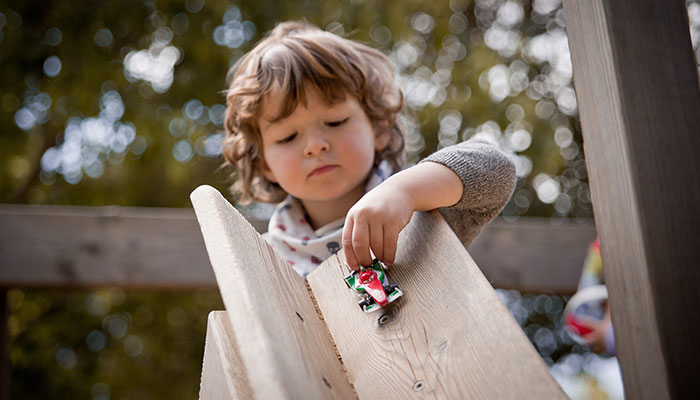While we believe that the books and resources recommended may be of value to you, keep in mind that these are suggestions only and you must do your own due diligence to determine whether the materials are appropriate and suitable for your use. PNC has no sponsorship or endorsement agreement with the authors or publishers of the materials listed.

TRANSPORTATION
Rolling with Ramps
Children will experiment with ramps and vehicles with wheels.

Lesson Objective
Children will experiment with vehicles and ramps to discover how the height of a ramp affects the speed and traveling distance of a vehicle with wheels.
Science
What You'll Need
- Variety of toy vehicles with wheels – at least one per child
- 3 pieces of strong cardboard – 3” x 1’ , 3” x 2’ , 3” x 3’ (to make ramps)
- Marker
- Chart paper – 2 sheets
- 12 large blocks of the same size
- Tape
What To Do
Note: Before beginning this experiment, make three ramps by taping each strip of cardboard to one of the blocks, raising each ramp the height of one block. Identify the ramps by writing 1, 2 and 3 on the cardboard.
- Tell the children they are going to experiment with ramps and vehicles with wheels. They are going to test these ramps to see which one allows the vehicles to travel the furthest and go the fastest.
- On a sheet of chart paper, draw three columns to keep tallies for each ramp.
- Share the toy vehicles and let the children play with them.
- One at a time, have each child select a vehicle and push it across the floor to see how far it rolls. Have the children discuss each vehicle, describing its color, shape, size, and how far it rolled.
- Ask the children about the movement of the vehicles (see Did You Know?).
- Show the children the ramps. Tell them they are going to use the ramps with blocks to create an incline, or a ramp. Then they are going to test their vehicles to see which ramp lets the vehicles go the fastest and the furthest.
- Have the children make predictions about which ramp will make their vehicles travel the furthest and why. Chart their predictions.
- One at a time, have the children roll their vehicles down each one of the ramps. Use tape to mark where the vehicle stops. Keep tallies in the columns that you drew on the chart paper, noting which ramp allowed the vehicles to travel the furthest. Ask questions about the experiment (see Guiding Student Inquiry).
- Try the experiment again, this time adding another block to each ramp.
- Let the children experiment further with the ramps, adding blocks to the ramps to raise them higher.
Resources
Home School Resources
Home educators: use these printable lesson PDFs to teach this lesson to your home schoolers. They're available in English and Spanish.
Content Provided By
Common Core State Standards Initiative – These lessons are aligned with the Common Core State Standards ("CCSS"). The CCSS provide a consistent, clear understanding of the concepts and skills children are expected to learn and guide teachers to provide their students with opportunities to gain these important skills and foundational knowledge [1]. Visit the CCSS


